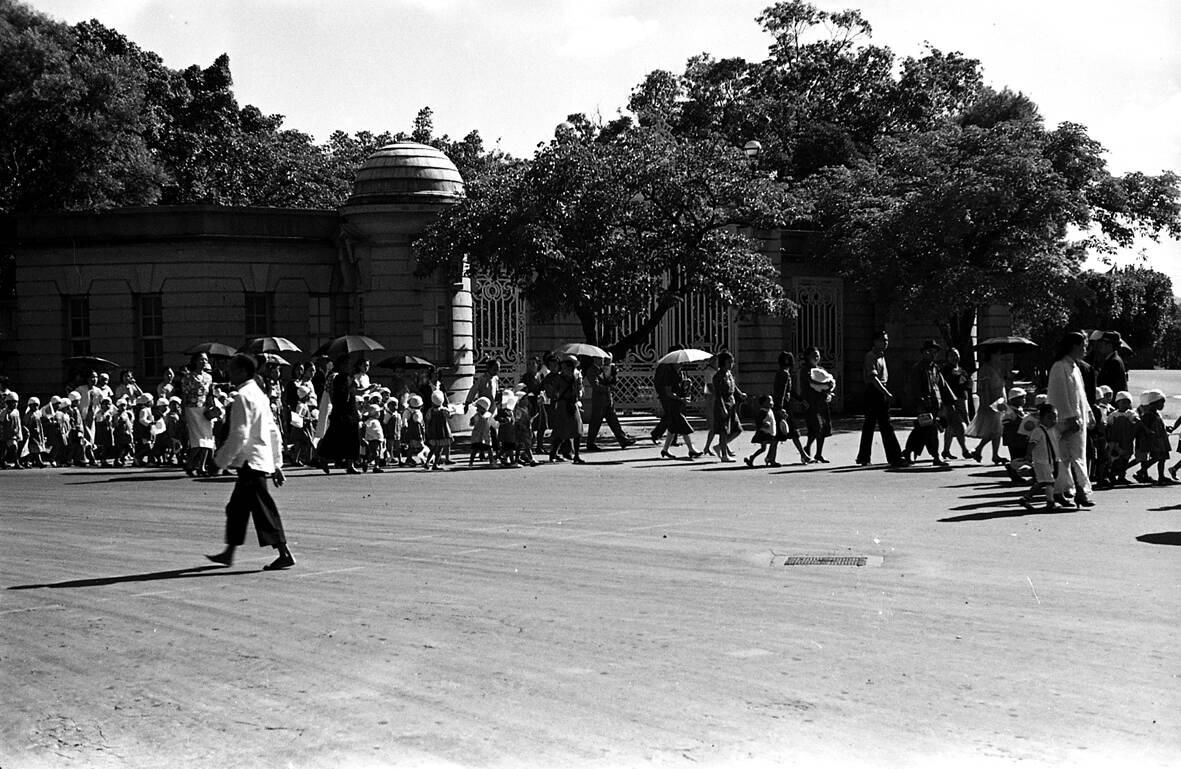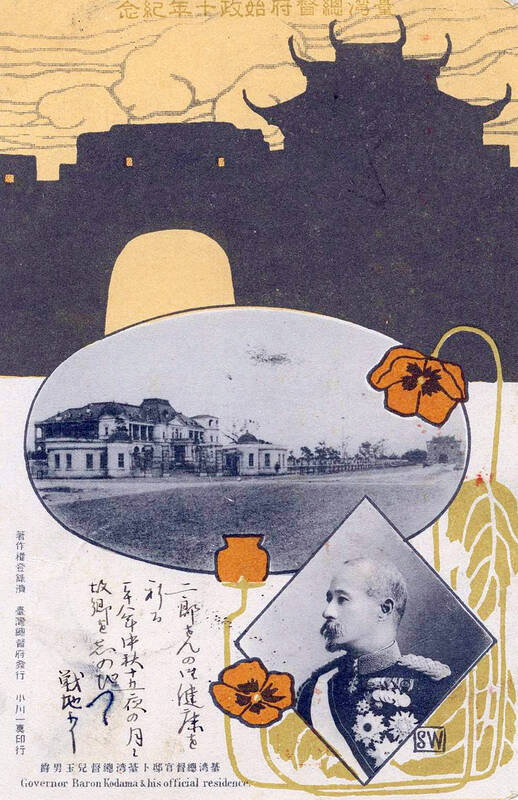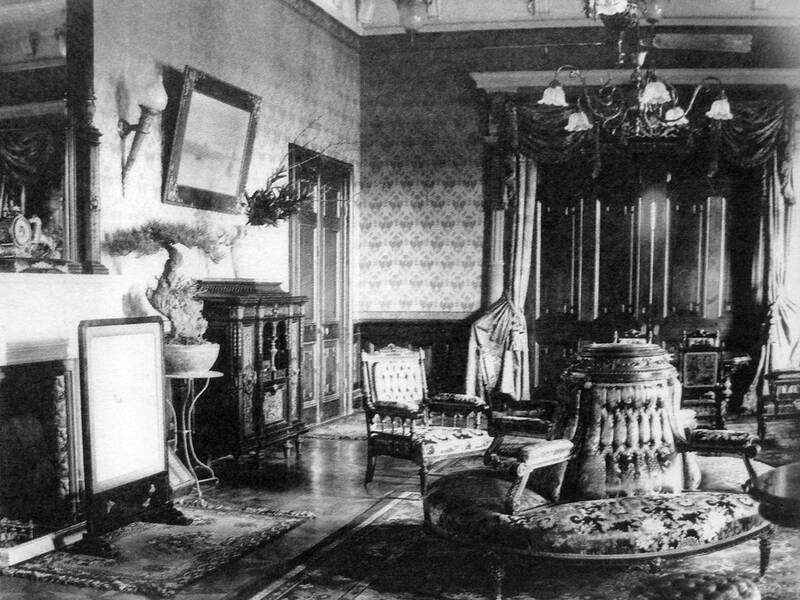Sept. 26 to Oct. 2
Members of the Japanese Diet were appalled at the ever-increasing costs to build Governor-General Gentaro Kodama’s residence in Taipei. Not only did the colonial government keep adding items to the grand complex, they also tapped into funds allocated for the Taiwan Shinto Shrine. That was blasphemy!
“I can’t imagine how much they would have spent to build what kind of palace if Shimpei Goto had his way,” civil engineer Hampei Nagao recalls in Story of the Governor-General’s Office (總督府物語), a book by Huang Chun-ming (黃俊銘).

Photo courtesy of Wikimedia Commons
Goto, the civil administrator of Taiwan, was summoned to Japan to explain. He asserted that the residence represented the emperor’s authority in the nation’s southward expansion, and of course it had to be as stately and beautiful as possible. How else would the Taiwanese, most of whom had never been to Japan, fully understand the power and prosperity of the motherland?
The Renaissance-style mansion surrounded by a Japanese garden and wide boulevards was completed on Sept. 26, 1901. The governor-general not only lived in this complex, he also received guests, hosted banquets and hosted all sorts of celebrations and public events. It also served as his office until 1920, when the structure that houses today’s Presidential Office was completed.
The residence was built in conjunction with the Taiwan Shinto Shrine as the two main symbols of colonial might. All visiting royals stayed in the residence, and a wide, tree-lined road was built between the two sites, leading to the demolition of Taipei’s Qing Dynasty-era city walls.

Photo courtesy of Wikimedia Commons
To further accommodate the royals, the building was expanded and given a makeover in 1911, and this version still stands today as the Taipei Guest House on Ketagalan Blvd and Zhongshan South Road.
PREVIOUS RESIDENCES
The Japanese took Taipei with little resistance on June 14, 1895. The Governor General’s Office was temporarily set up in the Qing Dynasty’s Provincial Administration Hall, located next to today’s Zhongshan Hall.

Photo courtesy of Lafayette Digital Repository
The first governor-general, Sukenori Kabayama, also moved into the complex. The Japanese were not used to this traditional Chinese structure and tried to remake it to suit their habits; but ultimately, a Chinese building could never represent Japanese authority.
Kabayama only lived here for two months before he moved into the Western Learning Hall (西學堂), which was established in 1887 by Qing provincial governor Liu Ming-chuan (劉銘傳) to train officials to handle the increasing presence of Westerners in Taiwan. The school shut down in 1891 due to budget issues.
Like many structures of its time, the East-West hybrid complex consisted of three one-story brick structures with European arched verandas that formed a courtyard, but with Taiwanese-style red tile roofs. However, in December 1896, the third governor-general Maresuke Nogi built a Japanese-style house with tatamis next to the complex and lived there instead. The complex was later designated a historic site called the Nogi Hall, but it was demolished after World War II.

Photo courtesy of Wikimedia Commons
In August 1900, with the help of British engineer W. K. Burton (who designed Japan’s first skyscrapers), the government finalized an extensive urban planning project for Taipei, which included the governor-general’s residence and the Taipei Shinto Shrine. Civil engineer Yoshitaro Togawa says in Huang’s book that they were instructed to make them as stately as possible, and they were even ordered to begin construction and complete them around the same time.
MULTIFUNCTIONAL COMPLEX
Gentaro Kodama, the fourth governor-general, placed much importance on these two projects, and often rode his horse between the two sites to inspect construction progress. The shrine was dedicated to Prince Kitashirakawa Yoshihisa, who died while fighting the local resistance in the south in 1895. It needed to be completed before the sixth anniversary of his death on Oct. 27, 1901.
The residence was finished on Sept. 26, 1901, and the prince’s widow became the first royal to stay there when she arrived the following month to inaugurate the shrine.
“If the governor-general’s residence was the highest ruling authority in Taiwan, then the Taiwan Shinto Shrine symbolized the ruler of the motherland, the emperor,” Huang writes. “The urban planning around these two structures also demonstrated the close relationship between politics and religion.”
Designed by Togo Fukuda, the brick and stone Renaissance-style structure was surrounded on all sides with verandas. Unlike typical Japanese mansions, only the east wing of the second floor was completely private to the governor-general and his family.
The first floor contained the reception lobby, administrative offices, meeting rooms, a spacious banquet hall and a game room featuring billiards and other high-society entertainment.
During those days, if an important visitor brought a female companion, the governor-general and his wife would greet them first, then they would separate by gender into different rooms to socialize. This “female meeting room” was located on the second floor of the west wing, where the guest rooms, a small dining hall and servant quarters were also located. In the center of the second floor was a room displaying rare collectibles.
The trees in the garden were transplanted from Beitou District, and Kodama had two giant banyan trees moved here from today’s Guting area. To save money, they enlisted prisoners to help move the trees, and when power lines got in the way, Kodama asked the Department of Communications to temporarily sever them.
ROYAL ENJOYMENT
At first, the residence was not designed to accommodate royals, who usually traveled with dozens of people to serve their needs. By 1911, the wooden framing was also damaged by termites, so the government launched an expansion and renovation project.
The building took on more splendorous Baroque features, as designers added new columns, a Mansard roof, chandeliers and replaced the curtains, carpets and furniture. New lighting and heating systems were installed, as well as a tennis court.
Government affairs shifted to the governor-general’s office after 1920, and the residence was used mainly for cultural and social events. In October 1916, for example, 46 Shinto, Buddhist, Taoist and Christian leaders attended a religious discussion with the governor-general, and in October 1921, intellectuals and social elites enjoyed a poetry gathering where they wrote calligraphy and composed pieces on the spot.
Subsequent governor-generals held meet-and-greets in the garden, and Eizo Ishizuka’s reception in 1929 reportedly attracted more than 600 officials and civilians. Celebrations observing events such as the enthronement of the Showa Emperor, or the 30th anniversary of Japanese rule, were also held here.
The royals were the only guests allowed to stay at the residence. Crown Prince Hirohito fully enjoyed the facilities during his stay in 1923. After meeting with important locals on his first day, he played tennis, dined with Japanese officials in the banquet room, played billiards and then watched the welcoming lantern parade with 25,000 participants from the third-floor balcony. After Hirohito toured the colony and returned to Taipei, officials put on a massive Western-style banquet, with fireworks closing out the night.
After World War II, the provincial governor stayed in the residence until it was converted into the Taipei Guest House in 1950. The 1952 Treaty of Taipei, a peace agreement between Taiwan and Japan, was signed at the residence, and it continues to host similar functions as it did during the Japanese years.
Today, the residence opens once or twice per month to the public. Visit: subsite.mofa.gov.tw/entgh.
Taiwan in Time, a column about Taiwan’s history that is published every Sunday, spotlights important or interesting events around the nation that either have anniversaries this week or are tied to current events.

Most heroes are remembered for the battles they fought. Taiwan’s Black Bat Squadron is remembered for flying into Chinese airspace 838 times between 1953 and 1967, and for the 148 men whose sacrifice bought the intelligence that kept Taiwan secure. Two-thirds of the squadron died carrying out missions most people wouldn’t learn about for another 40 years. The squadron lost 15 aircraft and 148 crew members over those 14 years, making it the deadliest unit in Taiwan’s military history by casualty rate. They flew at night, often at low altitudes, straight into some of the most heavily defended airspace in Asia.

This month the government ordered a one-year block of Xiaohongshu (小紅書) or Rednote, a Chinese social media platform with more than 3 million users in Taiwan. The government pointed to widespread fraud activity on the platform, along with cybersecurity failures. Officials said that they had reached out to the company and asked it to change. However, they received no response. The pro-China parties, the Chinese Nationalist Party (KMT) and Taiwan People’s Party (TPP), immediately swung into action, denouncing the ban as an attack on free speech. This “free speech” claim was then echoed by the People’s Republic of China (PRC),

Many people in Taiwan first learned about universal basic income (UBI) — the idea that the government should provide regular, no-strings-attached payments to each citizen — in 2019. While seeking the Democratic nomination for the 2020 US presidential election, Andrew Yang, a politician of Taiwanese descent, said that, if elected, he’d institute a UBI of US$1,000 per month to “get the economic boot off of people’s throats, allowing them to lift their heads up, breathe, and get excited for the future.” His campaign petered out, but the concept of UBI hasn’t gone away. Throughout the industrialized world, there are fears that

Like much in the world today, theater has experienced major disruptions over the six years since COVID-19. The pandemic, the war in Ukraine and social media have created a new normal of geopolitical and information uncertainty, and the performing arts are not immune to these effects. “Ten years ago people wanted to come to the theater to engage with important issues, but now the Internet allows them to engage with those issues powerfully and immediately,” said Faith Tan, programming director of the Esplanade in Singapore, speaking last week in Japan. “One reaction to unpredictability has been a renewed emphasis on